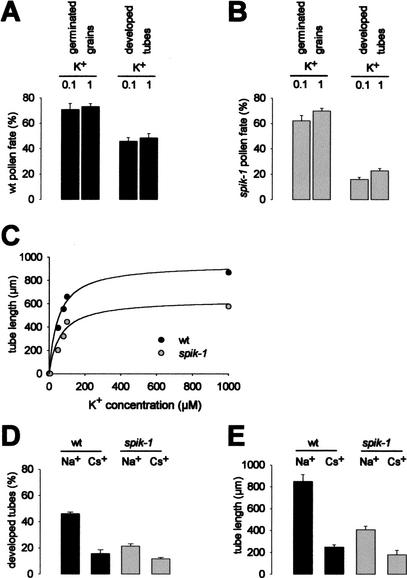Figure 5.
Quantitative analysis of wild-type and spik-1 pollen fate in vitro. (A,B) Quantification of germinated grains and developed tubes in (A) wild-type (wt) and (B) spik-1 pollen populations. The germination medium contained either 0.1 or 1 mM K+. Means ± SE of three independent experiments, each one including three replicates (at least 200 pollen grains per replicate). The differences between the percentages of developed tubes in the wild-type and the spik-1 populations are significant (P < 10−5, t-test) in both media. (C) Effect of external K+ concentration on wild-type (wt) and spik-1 pollen tube length. K+ concentrations below 100 μM were obtained by supplementing the 100 μM germination medium with the K+ chelator tetraphenylborate (TPB). Addition of 20 μM, 50 μM, and 100 μM TPB was calculated to reduce the free K+ concentrations to 80 μM, 50μM, and 5 μM (lowest concentration shown in the graph), respectively (see Materials and Methods). Mean ± SE for at least 300 tubes (SE bars smaller than the symbol size). Lines show hyperbolic fits to the data (least squares fits): apparent KM of 50 and 61 mM for wild-type and spik-1 pollen grains, respectively. (D,E) Effect of Cs+ on percentage of developed tubes (D) and tube length (E) for wild-type (black bars) or spik-1 (gray bars) pollen grains. Either 2 mM NaCl (control treatment) or 2 mM CsCl was added to 1 mM K+ germination medium. Mean ± SE for at least 800 pollen grains (D) and 50 pollen tubes (E) in both treatments. The depressive effect of Cs+ is significant (P < 10−3) in each genotype.

